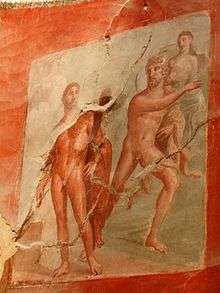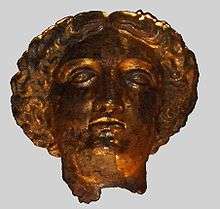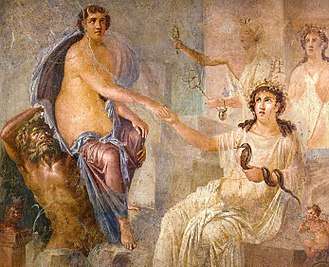Interpretatio graeca
Interpretatio graeca (Latin, "Greek translation") or "interpretation by means of Greek [models]" is a discourse[1] used to interpret or attempt to understand the mythology and religion of other cultures; a comparative methodology using ancient Greek religious concepts and practices, deities, and myths, equivalencies, and shared characteristics.
The phrase may describe Greek efforts to explain others' beliefs and myths, as when Herodotus describes Egyptian religion in terms of perceived Greek analogues, or when Dionysius of Halicarnassus and Plutarch document Roman cults, temples, and practices under the names of equivalent Greek deities. Interpretatio graeca may also describe non-Greeks' interpretation of their own belief systems by comparison or assimilation with Greek models, as when Romans adapt Greek myths and iconography under the names of their own gods.
Interpretatio romana is comparative discourse in reference to ancient Roman religion and myth, as in the formation of a distinctive Gallo-Roman religion. Both the Romans and the Gauls reinterpreted Gallic religious traditions in relation to Roman models, particularly Imperial cult.
Jan Assmann considers the polytheistic approach to internationalizing gods as a form of "intercultural translation":
The great achievement of polytheism is the articulation of a common semantic universe. ... The meaning of a deity is his or her specific character as it unfolded in myths, hymns, rites, and so on. This character makes a deity comparable to other deities with similar traits. The similarity of gods makes their names mutually translatable. … The practice of translating the names of the gods created a concept of similarity and produced the idea or conviction that the gods are international.[2]
Pliny the Elder expressed the "translatability" of deities as "different names to different peoples" (nomina alia aliis gentibus).[3] This capacity made possible the religious syncretism of the Hellenistic era and the pre-Christian Roman Empire.
Examples

Herodotus was one of the earliest authors to engage in this form of interpretation. In his observations regarding the Egyptians, he establishes Greco-Egyptian equivalents that endured into the Hellenistic era, including Amon/Zeus, Osiris/Dionysus, and Ptah/Hephaestus. In his observations regarding the Scythians, he equates their queen of the gods, Tabiti, to Hestia, Papaios and Api to Zeus and Gaia respectively, and Argimpasa to Aphrodite Urania, whilst also claiming that the Scythians worshipped equivalents to Herakles and Ares, but which he doesn't name.
Some pairs of Greek and Roman gods, such as Zeus and Jupiter, are thought to derive from a common Indo-European archetype (Dyeus as the supreme sky god), and thus exhibit shared functions by nature. Others required more expansive theological and poetic efforts: though both Ares and Mars are war gods, Ares was a relatively minor figure in Greek religious practice and deprecated by the poets, while Mars was a father of the Roman people and a central figure of archaic Roman religion.
Some deities dating to Rome's oldest religious stratum, such as Janus and Terminus, had no Greek equivalent. Other Greek divine figures, most notably Apollo, were adopted directly into Roman culture, but underwent a distinctly Roman development, as when Augustus made Apollo one of his patron deities. In the early period, Etruscan culture played an intermediary role in transmitting Greek myth and religion to the Romans, as evidenced in the linguistic transformation of Greek Heracles to Etruscan Her[e]cle to Roman Hercules.
Interpretatio romana
The phrase interpretatio romana was first used by the Imperial-era historian Tacitus in the Germania.[4] Tacitus reports that in a sacred grove of the Nahanarvali, "a priest adorned as a woman presides, but they commemorate gods who in Roman terms (interpretatione romana) are Castor and Pollux."[5] Elsewhere,[6] he identifies the principal god of the Germans as Mercury, perhaps referring to Wotan.[7]

Some information about the deities of the ancient Gauls (the continental Celts), who left no written literature other than inscriptions, is preserved by Greco-Roman sources under the names of Greek and Latin equivalents. A large number of Gaulish theonyms or cult titles are preserved, for instance, in association with Mars. As with some Greek and Roman divine counterparts, the perceived similarities between a Gallic and a Roman or Greek deity may reflect a common Indo-European origin.[8] Lugus was identified with Mercury, Nodens with Mars as healer and protector, Sulis with Minerva. In some cases, however, a Gallic deity is given an interpretatio romana by means of more than one god, varying among literary texts or inscriptions. Since the religions of the Greco-Roman world were not dogmatic, and polytheism lent itself to multiplicity, the concept of "deity" was often expansive, permitting multiple and even contradictory functions within a single divinity, and overlapping powers and functions among the diverse figures of each pantheon. These tendencies extended to cross-cultural identifications.[9]
In the Eastern empire, the Anatolian storm god with his double-headed axe became Jupiter Dolichenus, a favorite cult figure among soldiers.
Application to the Jewish religion
Roman scholars such as Varro interpreted the monotheistic god of the Jews into Roman terms as Caelus or Jupiter Optimus Maximus. Some Greco-Roman authors seem to have understood the Jewish invocation of Yahweh Sabaoth as Sabazius.[10] In a similar vein, Plutarch gave an example of a symposium question 'Who is the god of the Jews?,' by which he meant:'What is his Greek name?' as we can deduct from the first speaker at the symposium, who maintained that the Jews worshiped Dionysus, and that the day of Sabbath was a festival of Sabazius. We don't know what the other speakers thought, because the text is incomplete.[11]
From the Roman point of view, it was natural to apply the above principle also to the Jewish God Jehovah and equate him with Jupiter. However, the Jews – unlike other peoples living under Roman rule – rejected out of hand any such attempt, regarding such an identification as the worst of sacrilege. This complete divergence of views was one of the factors contributing to the frequent friction between the Jews and the Roman Empire – for example, the Emperor Hadrian's decision to rebuild Jerusalem under the name of Aelia Capitolina, a city dedicated to Jupiter, precipitated the bloodbath of the Bar Kokhba revolt.
In late antiquity mysticism, the sun god Helios is sometimes equated to the Judeo-Christian God.[12]
Greco-Mediterranean equivalents
The following is a list of Greek, Roman, Etruscan, Egyptian, and Phoenician equivalents, based on usage among the ancients themselves, supported by the analyses of modern scholars. "Equivalent" should not be taken to mean "the same god". For instance, when the myths or even cult practices of a particular Roman deity were influenced by the Etruscan or Greek tradition, some minor deities may have had an independent origin and a tradition that is culturally distinctive.
| Greek | Greek (Romanized) | Roman | Roman (Anglicized) | Etruscan | Egyptian | Phoenician | Parthian
(Hellenistic period) |
Functions |
|---|---|---|---|---|---|---|---|---|
| Ἄδωνις | Adonis | Atunis | Osiris | Adōn/Tammuz | agriculture; resurrection | |||
| Ἀμφιτρίτη | Amphitrite | Salacia | Hatmehit | sea goddess | ||||
| Ἀνάγκη | Ananke | Necessitas | force, constraint, necessity | |||||
| Ἄνεμοι | Anemoi | Venti | Vayu-Vata | winds | ||||
| Ἀφροδίτη | Aphrodite | Venus | Turan | Hathor, Isis | Astarte | Anahita | beauty; sex; love | |
| Ἀπόλλων (Apollōn) / Φοῖβος (Phoibos) |
Apollo / Phoebus | Aplu | Horus / Ra | Resheph | Mithra | light; prophecy; healing; plagues; music; poets | ||
| Ἄρης | Ares | Mars | Laran | Anhur | Verethragna | war | ||
| Ἄρτεμις | Artemis | Diana | Artume | Bast | Kotharat | Drvaspa | hunting, the hunt; wilderness, wild animals; virginity, childbirth; Diana: lit. heavenly or divine | |
| Ἀσκληπιός (Asklēpios) | Asclepius | Aesculapius / Vejovis | Vejove | Vetis | Imhotep | Eshmun | healing | |
| Ἀθηνᾶ (Athēnā), Ἀθήνη (Athēnē) | Athena / Athene | Minerva | Menrva | Neith, Isis | Anat | Anahita | wisdom; strategy; the arts and crafts; weaving | |
| Ἄτλας (Átlas) | Atlas | Aril | holder of the celestial spheres | |||||
| Ἄτροπος | Atropos | Morta | Leinth | Atropos: lit. inflexible; death | ||||
| Βορέας | Boreas | Aquilo | Andas | North Wind or Devouring One | ||||
| Καλλιόπη (Kalliopē) | Calliope | "beautifully voiced"; muse of eloquence and epic poetry | ||||||
| Χάος (Kháos) | Chaos | Nu | chasm, vast void, abyss; the formless, primordial state of existence | |||||
| Naunet | ||||||||
| Χάριτες (Kharites) | Charites | Gratiae | Graces | grace; splendor; festivity; charity | ||||
| Χάρων (Kharōn) | Charon | Charun | fierce, flashing, feverish gaze (eyes) | |||||
| Χλωρίς (Khlōris) | Chloris | Flora | Chloris: lit. greenish-yellow, pale green, pale, pallid, fresh; Flora: lit. flower | |||||
| Κλωθώ (Klōthō) | Clotho | Nona | spinning; thread | |||||
| Κρόνος (Kronos) | Cronus | Saturnus | Saturn | Satre | Geb | El | Time | |
| Κυβέλη (Kybelē) | Cybele | Magna Mater | Magna Mater: lit. Great Mother | |||||
| Δημήτηρ | Demeter | Ceres | Zerene | Isis | Ashi | grains, agricultural fertility; Demeter: lit. Earth Mother | ||
| Διόνυσος (Dionysos) / Βάκχος (Bakkhos) |
Dionysus / Bacchus | Liber / Bacchus | Fufluns | Osiris | wine and winemaking; revelry; ecstasy; Liber: lit. the free one | |||
| Εἰλείθυια | Eileithyia / Ilithyia | Lucina | Ilithiia | Meskhenet | childbirth, midwifery | |||
| Ἐνυώ | Enyo | Bellona | Enie | Sekhmet | war | |||
| Ἠώς | Eos | Aurora / Matuta | Thesan | Tefnut | dawn | |||
| Ἔρεβος (Érebos) | Erebus | Scotus | darkness | |||||
| Ἐρινύες | Erinyes | Dirae / Furiae | Furies | Furies | ||||
| Ἔρις | Eris | Discordia | Eris | Anat | strife | |||
| Ἔρως | Eros | Cupido / Amor | Cupid | Erus | sexual love | |||
| Eὐτέρπη | Euterpe | Euturpa / Euterpe | "she who delights"; muse of music (especially flute music) and song; later, also of lyric poetry | |||||
| Εὖρος (Euros) | Eurus | Vulturnus | East Wind | |||||
| Γαῖα | Gaia / Gaea | Terra / Tellus | Cel | Zam | the earth | |||
| ᾍδης (Hāidēs) / Πλούτων (Ploutōn) |
Hades / Pluto | Dis Pater / Pluto / Orcus | Aita | Anubis / Osiris | Mot | Angra Mainyu | the underworld. Hades: lit. the unseen | |
| Ἥβη (Hēbē) | Hebe | Iuventas | Juventas | Renpet | youth | |||
| Ἑκάτη (Hekatē) | Hecate | Trivia | Heqet | will; Hecate: trans. she who has power far off [13] | ||||
| Ἥλιος | Helios | Sol | Usil | Ra | sun | |||
| Ἡμέρα | Hemera | Dies | day | |||||
| Ἥφαιστος (Hḗphaistos) | Hephaestus | Vulcanus | Vulcan | Sethlans | Ptah | Atar | metalwork, forges; fire, lava | |
| Ἥρα | Hera | Iuno | Juno | Uni | Mut, Hathor | Shala | Armaiti | marriage, family |
| Ἡρακλής (Hēraklē̂s) | Heracles | Hercules | Hercle | Heryshaf | Melqart | Rostam (Heracles) | Heracles: lit. glory of Hera | |
| Ἑρμῆς | Hermes | Mercurius | Mercury | Turms | Anubis, Thoth | Shamash | transitions; boundaries; thieves; travelers; commerce; Hermes: poss. "interpreter"; Mercurius: related to Latin "merx" (merchandise), "mercari" (to trade), and "merces" (wages) | |
| Ἕσπερος (Hesperos) | Hesperus | Vesper | evening, supper, evening star, west[14] | |||||
| Ἕστία | Hestia | Vesta | hearth, fireplace, domesticity | |||||
| Ὑγίεια | Hygeia | Salus | health; cleanliness | |||||
| Ὕπνος | Hypnos | Somnus | sleep | |||||
| Εἰρήνη (Eirēnē) | Irene | Pax | peace | |||||
| Ἶρις | Iris | Arcus / Iris | Nut | rainbow | ||||
| Ἰανός | Ianus | Janus | Culsans | beginnings; transitions; motion; doorways | ||||
| Λάχεσις (Lakhesis) | Lachesis | Decima | Lachesis: lit. disposer of lots; luck | |||||
| Λητώ | Leto | Latona | Demureness; mothers | |||||
| Μοῖραι (Moirai) | Moirai / Moerae | Parcae / Fatae | Fates | Apportioners | ||||
| Μοῦσαι (Mousai) | Musae | Camenae | Mus | Music; inspiration | ||||
| Νίκη | Nike | Victoria | Meanpe | victory | ||||
| Νότος (Notos) | Notus | Auster | South Wind | |||||
| Νύξ (Nyx) | Nyx | Nox | Nephthys | night | ||||
| Ὀδυσσεύς | Odysseus | Ulixes / Ulysses | Ulysses | Uthste | hero | |||
| Παλαίμων (Palaimōn) | Palaemon | Portunus | keys, doors; ports, harbors | |||||
| Πᾶν | Pan | Faunus | Min | nature, the wild | ||||
| Περσεφόνη | Persephone | Proserpina | Proserpine | Persipnei | poss. "to emerge" | |||
| Φάων | Phaon | Phaun / Faun / Phamu | mortal boatman given youth and beauty by Aphrodite | |||||
| Φήμη | Pheme | Fama | fame; rumor | |||||
| Φωσφόρος (Phōsphoros) | Phosphorus | Lucifer | Attar | lit. light bearer | ||||
| Ποσειδῶν | Poseidon | Neptunus | Neptune | Nethuns | Apam Napat | sea; water; horses; earthquakes | ||
| Πρίαπος (Priapos) | Priapus | Mutunus Tutunus / Mutinus Titinus | fertility; livestock; gardens; male genitalia | |||||
| Προμηθεύς | Prometheus | Prumathe | forethought | |||||
| Ῥέα | Rhea | Opis / Magna Mater (See Cybele, above) |
Ops | Nut | Asherah | Rhea: lit. flowing. Ops: lit. wealth, abundance, resources. | ||
| Σελήνη | Selene | Luna | Losna | Isis | Mah | moon | ||
| Tiur | ||||||||
| Σειληνός | Silenos | Silvanus | Selvans | Silvanus: lit. of the woods | ||||
| Θάνατος | Thanatos | Mors | Leinth | Anubis | Mot | death | ||
| Charun | ||||||||
| Θέμις | Themis | Iustitia | Justitia / Justice | Maat | law of nature | |||
| Τύχη (Tykhē) | Tyche | Fortuna | Fortune | Nortia | luck, fortune | |||
| Τυφῶν ("Typhon") | Typhoeus | Typh | Set | "whirlwinds, storms, chaos, darkness" | ||||
| Οὐρανός (Ouranos) | Uranus | Caelus | Asman | sky | ||||
| Vertumnus | Voltumna | the seasons; change | ||||||
| Ζέφυρος (Zephyros) | Zephyrus / Zephyr | Favonius | West Wind; Favonius: lit. favorable | |||||
| Ζεύς | Zeus | Iuppiter / Iovis | Jupiter / Jove | Tinia | Amun / Horus | Dagon / Hadad | Ohrmazd / Ahura Mazda | Sky Father |
In art
Examples of deities depicted in syncretic compositions by means of interpretatio graeca or romana:
- Jupiter Ammon (terracotta of Hellenistic style, 1st century AD)
 Syncretized figure from the Eastern provinces, perhaps a Genius (1st century BC – 1st century AD)
Syncretized figure from the Eastern provinces, perhaps a Genius (1st century BC – 1st century AD)
 Isis, Serapis, the child Harpocrates and Dionysos (relief from Roman Africa, late 2nd century AD)
Isis, Serapis, the child Harpocrates and Dionysos (relief from Roman Africa, late 2nd century AD) Worshipper before Zeus–Serapis–Ohrmazd (Bactria, 3rd century AD)
Worshipper before Zeus–Serapis–Ohrmazd (Bactria, 3rd century AD)
See also
- Aion (deity)
- Mystery religions
- Honji suijaku, in Japan
- Interpretatio Christiana
- Proto-Indo-European religion, the ancestor of the Greek religion
- Shinbutsu-shūgō, a Japanese amalgamation of Buddhist and Shinto deities
- Syncretism
References
- Characterized as "discourse" by Mark S. Smith, God in Translation: Deities in Cross-Cultural Discourse in the Biblical World (Wm. B. Eerdmans, 2008, 2010), p. 246.
- Moses the Egyptian: The Memory of Egypt in Western Monotheism (Harvard University Press, 1997), pp. 44–54 (quotation p. 45), as cited by Smith, God in Translation, p. 39.
- Pliny, Natural History 2.5.15.
- Tacitus, Germania 43.
- "Praesidet sacerdos muliebri ornatu, sed deos interpretatione romana Castorem Pollucemque memorant."
- Tacitus, Germania 9.
- Robert Leo Odom, ''Sunday in Roman Paganism'' (TEACH 2003 ISBN 978-1-57258242-2), pp. 251-252. Books.google.com. 2003-01-01. ISBN 9781572582422. Retrieved 2013-01-24.
- John T. Koch, "Interpretatio romana," in Celtic Culture: A Historical Encyclopedia (ABC-Clio, 2006), p. 974.
- Koch, "Interpretatio romana," in Celtic Culture, pp. 974–975; Assmann, Moses the Egyptian, p. 45.
- (Valerius Maximus), epitome of Nine Books of Memorable Deeds and Sayings, i. 3, 2, see EXEMPLUM 3. [Par.]
- Plutarch. Symposiacs, iv, 6.
- Eleni Pachoumi, The Religious and Philosophical Assimilation of Helios in the Greek Papyri
- "Henry George Liddell, Robert Scott, A Greek-English Lexicon, ἕκα^τος". Perseus.tufts.edu. Retrieved 2013-01-24.
- Collins Latin Dictionary plus Grammar, p. 231. ISBN 0-06-053690-X)
Further reading
- Assmann, Jan (2008). "Translating Gods: Religion as a Factor of Cultural (Un)Translatability". In de Vries, Hent (ed.). Religion: Beyond a Concept. Fordham University Press. ISBN 9780823227242.
- Kaspers, Wilhelm. "Germanische Götternamen." Zeitschrift Für Deutsches Altertum Und Deutsche Literatur 83, no. 2 (1951): 79-91. www.jstor.org/stable/20654522.
- Pakkanen, Petra (1996). Interpreting Early Hellenistic Religion: A Study Based on the Mystery Cult of Demeter and the Cult of Isis. Foundation of the Finnish Institute at Athens. ISBN 978-951-95295-4-7.
